This EDIS publication, focusing on the general public's perceptions of invasive species, is the second of a two-part EDIS publication series. The series aims to help Extension faculty understand public perceptions of invasive species and use this in their programming with clientele. This series includes the following publications:
- Floridians' Perceptions of Endangered Species
- Floridians' Perceptions of Invasive Species
Introduction
Invasive species are a serious threat in Florida. Invasive species are defined as non-native or exotic organisms, which cause ecological or economic harm or negatively affect human health in a new environment where they are not historically found (United States Fish and Wildlife Service [USFWS] 2012b). An invasive species can be a plant, animal, or other type of organism (Evans 2012). Because invasive species' natural predators and parasites usually are not present in the new environment, their populations can grow unchecked causing significant impacts in the new environment (Demers, Long, and Williams 2002; United States Geological Survey 2013). Damage caused by invasive species can take different forms and in extreme cases can lead to the extinction of native species, disruption of ecosystem functioning, decimation of crops, or complete loss of recreation sites (USFWS 2012a). Other impacts of invasive species can include decreased land value, reduced revenues to natural resource based industries, and decreased tourism.
In the past 200 years over 50,000 foreign species of plants and animals have become established in the U.S. (Evans 2012). Nearly one in seven of these introduced non-native species has become invasive. It is costly to combat invasive species; damage, losses, and control costs across the U.S. are estimated at almost $120 billion each year (Pimentel, Zuniga, and Morrison 2005). In Florida alone, more than 500 non-native fish and wildlife species have been observed, and over 1,180 non-native plant species have become established outside of human cultivation (Florida Fish and Wildlife Conservation Commission[FWC] 2014; Schmitz 2002). Fortunately, few of these have become invasive, yet Florida still ranks as one of the top four areas in the U.S. facing serious problems with invasive species (University of Georgia 2014; USFWS 2012b). Due to its climate and geographic location, Florida is particularly vulnerable and at high risk for the introduction, establishment, and spread of invasive species (Schmitz 2002). Some of the most abundant, widespread, and harmful invasive species in Florida include citrus canker, Brazilian peppertree, melaleuca, hydrilla, Chinese tallowtree, cane toad, congongrass, Japanese climbing fern, chinaberry, Burmese python, and water hyacinth (University of Georgia 2014; Torrent 2011).
Even a few invasive species can have enormous economic and ecological impact. While permanently eradicating these invasive species may not be possible, keeping them under control and maintained will lessen their populations. For example, the state has spent over $300 million to control a single invasive species: citrus canker (Schmitz, 2002). Another economic impact includes agricultural losses due to invasive plants, animals, and diseases, estimated at $179 million annually in Florida (Schmitz, 2002). Measuring economic impact is challenging due to a lack of data and difficulties measuring the cost of indirect impacts, which has resulted in many studies being limited in scope (Evans, 2012).
Many invasive species are introduced and spread by human activities. Ships, wood products, ornamental plants, and pet trade often carry uninvited species into the U.S. (National Wildlife Federation, n.d.). Therefore, understanding public perceptions, beliefs, and knowledge, about invasive species can be useful in developing communication and educational programming for the public as one strategy to combat the introduction and spread of invasive species. Enhancing and conserving Florida's natural resources and environmental quality is a priority initiative in the UF/IFAS Florida Cooperative Extension Service's 2013–2023 Florida Extension Roadmap (https://pdec.ifas.ufl.edu/roadmap/FloridaExtensionRoadmap_2013-2023.pdf) (University of Florida Institute of Food and Agricultural Sciences Extension 2013). The role that Extension faculty play in helping the public understand Florida's natural resources and threats to these resources, including invasive species, contributes to the success of this initiative and will help communities respond to natural resource challenges (Miller, Dodds, and Lamm 2014).
This EDIS publication summarizes Florida residents' perceptions, concerns, and knowledge about invasive species. This information will equip Extension faculty to more effectively communicate and educate clientele on this topic (Miller et al. 2014).
Background
The UF/IFAS Center for Public Issues Education in Agricultural and Natural Resources (PIE Center) initiated a study to explore the attitudes, perceptions, opinions, and knowledge of Floridians about endangered and invasive species. In July 2014, an online survey was distributed to a representative sample of Florida residents using non-probability sampling. The survey was distributed to Florida residents 18 and older, and 515 completed responses were collected (Odera and Lamm 2014, Miller et al. 2014). To ensure respondents were representative of the 2010 U.S. Census, the data were weighted to balance their geographic location in the state, age, gender, and race (Kalton and Flores-Cervantes 2003).
Results
In order to understand Floridians' perceptions, knowledge, and opinions of invasive species, respondents were asked questions about their overall knowledge of invasive species, level of interest in news on invasive species, interest in topics related to invasive species, and preferred modes of learning.
Overall Knowledge
To examine how knowledgeable Floridians feel about invasive species, respondents were given the question "How knowledgeable do you feel you are about invasive species in general?" and asked to indicate their knowledge level on a five-point scale (1 = Not Knowledgeable, 2 = Slightly Knowledgeable, 3 = Fairly Knowledgeable, 4 = Highly Knowledgeable, 5 = Extremely Knowledgeable). Sixty-two percent of the respondents felt that they were either not knowledgeable or slightly knowledgeable about the topic (Figure 1).
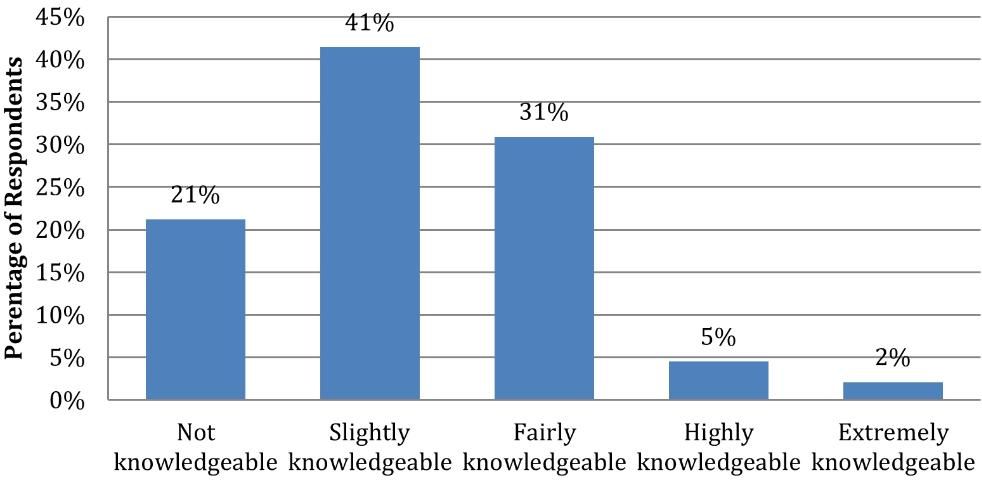
To examine their knowledge about the types of invasive species and preventing invasive species introductions, respondents were given the statement "Please indicate your level of knowledge related to the following invasive topics" and asked to indicate their knowledge level on these topics on a five-point scale (1 = Not Knowledgeable, 2 = Slightly Knowledgeable, 3 = Fairly Knowledgeable, 4 = Highly Knowledgeable, 5 = Extremely Knowledgeable). Sixty-three percent of respondents admitted they were either not knowledgeable or only slightly knowledgeable on the types of invasive species living in Florida. Similarly, 66 percent felt they were not knowledgeable or only slightly knowledgeable about how to prevent invasive species from entering Florida (Figure 2).
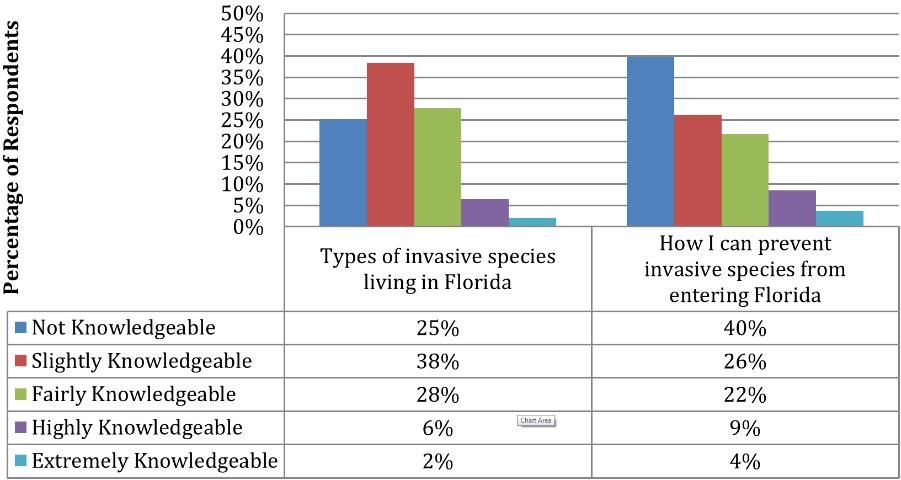
News Interest
To examine Floridians' interest in news articles about invasive species, respondents were given the question "How likely are you to pay attention to a news story dealing with issues related to invasive species?" and asked to indicate their likelihood on five-point scale (1 = Very Likely, 2 = Unlikely, 3 = Undecided, 4 = Likely, and 5 = Very Likely. Seventy-nine percent were likely or very likely to pay attention to an invasive species news article (Figure 3).
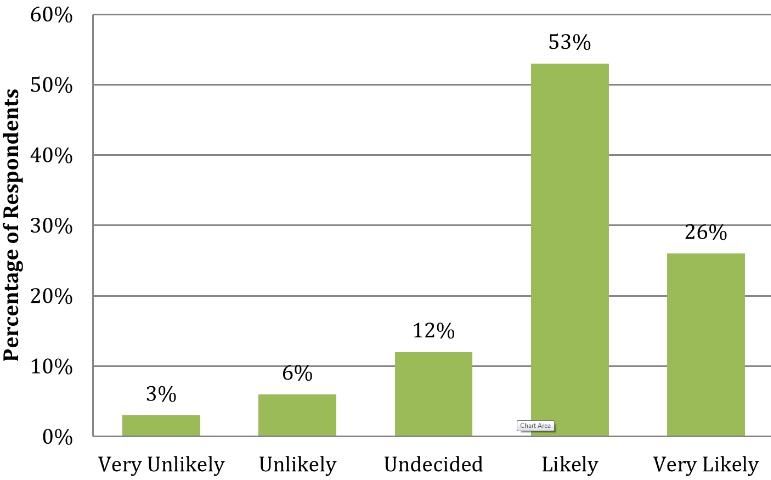
Educational Topics and Learning Mode
Respondents were asked to indicate what topics related to invasive species they would like to learn more about. Sixty-four percent would like to learn about the types of species that are invasive. Fifty-one percent would like to learn more about strategies for managing invasive species. Thirty-nine percent would like to learn more about the process by which a species becomes invasive (Figure 4).
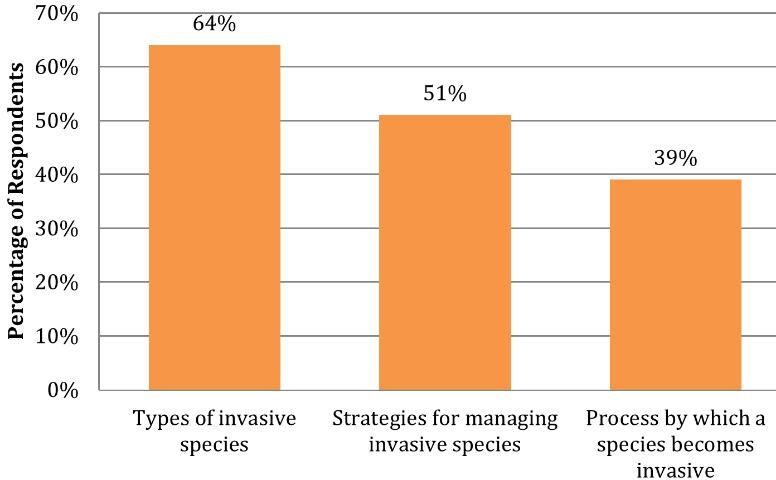
Next, they were asked what type of learning opportunities they would be most likely to take advantage of to learn about invasive species topics. They were presented with a list of options and asked to check all that apply. Respondents preferred watching TV coverage (76 percent), visiting a website (75 percent), watching a video (74 percent), or reading printed fact sheets, bulletins, or brochures (72 percent) (Figure 5).
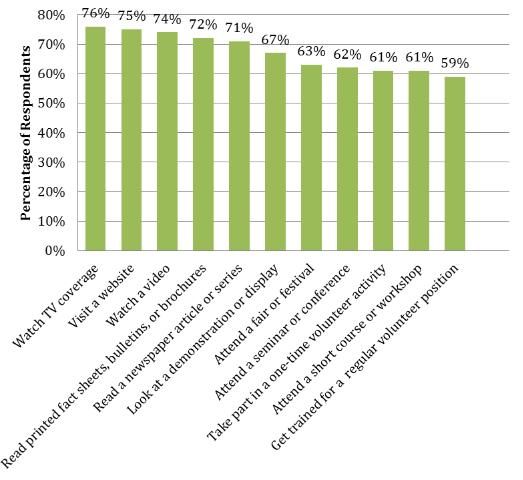
Recommendations
Floridians do not consider themselves knowledgeable about invasive species topics including types of invasive species and how to prevent them from entering Florida. Yet respondents indicated interest in learning about invasive species, particularly through viewing news and watching TV coverage. This self-reported low level of knowledge paired with an interest in learning presents a unique opportunity for Extension faculty to develop media campaigns to deliver information on invasive species, particularly the types of invasive species in Florida; methods for preventing the introduction of invasive species, and strategies for managing invasive species.
Extension faculty also can incorporate information about invasive species into existing programming focused on natural resources, agriculture, and horticulture. At these programs, additional information on invasive species could best be relayed through a website, video, or printed fact sheets, bulletins, or brochures. Clientele also can be encouraged to report invasive species sightings by calling 1-888-IVE-GOT-1 or on the website https://www.eddmaps.org/florida/report/index.cfm.
Extension faculty can serve as community facilitators to help increase coordination and partnerships among management agencies addressing invasive species introduction and management. Interaction and coordination with Cooperative Invasive Species Management Areas (CISMAs) could be one role for Extension faculty. To find out more visit: https://www.floridainvasives.org/cismas/.
The Florida Fish and Wildlife Conservation Commission has set a series of priorities for education and outreach efforts on the topics of invasive species (FWC 2012). Extension faculty could cooperate with existing agency efforts to:
- Promote Pet Amnesty days.
- Develop and implement education programs at public access points to water bodies, focused on stopping the release of non-native animals to those habitats.
- Develop and implement education programs aimed at nursery and plant distributors to increase awareness and label plants as native or non-native.
- Educate public utility companies to implement standards to prevent invasive species along utility corridors.
- Develop demonstration programs to show clientele how to control invasive species and provide training for volunteer programs to help control invasive species.
- Educate pet stores owners of the risks associated with invasive species and about proper disposal of unwanted pets.
References
Demers, C., A. Long, and R. Williams. 2012. "Controlling Invasive Exotic Plants in North Florida Forests." SS-FOR19. Gainesville, FL: University of Florida Institute of Food and Agricultural Sciences. https://doi.org/10.32473/edis-fr133-2012
Evans, E. A. 2012. "Economic Dimension of the Problem of Invasive Species." FE386. Gainesville, FL: University of Florida Institute of Food and Agricultural sciences. https://original-ufdc.uflib.ufl.edu/IR00005100/00001
Florida Fish and Wildlife Conservation Commission. 2012. Florida's State Wildlife Action Plan. https://myfwc.com/conservation/special-initiatives/swap/
Florida Fish and Wildlife Conservation Commission. 2014. Florida's Exotic Fish and Wildlife. https://myfwc.com/wildlifehabitats/nonnatives/.
Kalton, G. and I. Flores-Cervantes. 2003. "Weighting methods." Journal of Official Statistics 19(2):81–97.
Miller, M. H., N. Dodds, and A. Lamm. 2014. "Floridians' perceptions of endangered species." WC185. Gainesville, FL: University of Florida Institute of Food and Agricultural Sciences. https://edis.ifas.ufl.edu/publication/wc185.
National Wildlife Federation. n.d. Invasive species. https://www.nwf.org/Educational-Resources/Wildlife-Guide/Threats-to-Wildlife/Invasive-Species
Odera, E. and A. Lamm. 2014. "Public opinion of endangered and invasive species in Florida." PIE2012/13-13. Gainesville, FL: University of Florida/IFAS Center for Public Issues Education. https://www.piecenter.com/wp-content/uploads/2014/08/Endangered__Year2_ReportFINAL.pdf.
Pimentel, D., R. Zuniga, and D. Morrison. 2005. "Update on the environmental and economic costs associated with alien-invasive species in the United States." Ecological Economics 52(3), 273–288. https://doi.org/10.1016/j.ecolecon.2004.10.002
Schmitz, D. C., ed. 2002. Statewide invasive species strategic plan for Florida 2002. South Florida Ecosystem Restoration Task Force.
Torrent, D. 2011. "UF-led study: Invasive amphibians, reptiles in Florida outnumber world." https://news.ufl.edu/archive/2011/09/uf-led-study-invasive-amphibians-reptiles-in-florida-outnumber-world.html.
U.S. Fish and Wildlife Service. 2012a. "The Cost of Invasive Species."
U. S. Fish and Wildlife Service. 2012b. "Invasive Species: Frequently Asked Question About Invasive Species."
U. S. Geological Survey. 2013. Invasive species program. https://www.usgs.gov/programs/invasive-species-program
University of Florida Institute of Food and Agricultural Sciences Extension. 2013. Shaping solutions for Florida's future: The UF/IFAS extension roadmap 2013–2023. https://pdec.ifas.ufl.edu/roadmap/FloridaExtensionRoadmap_2013-2023.pdf
University of Georgia. 2014. Status of Invasive Plants in Florida. https://www.eddmaps.org/tools/statereport.cfm?id=us_fl